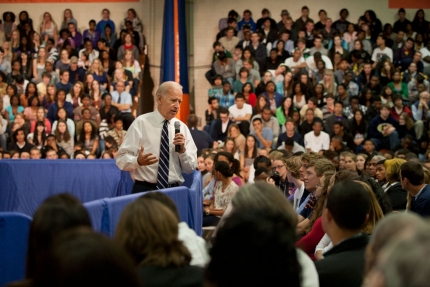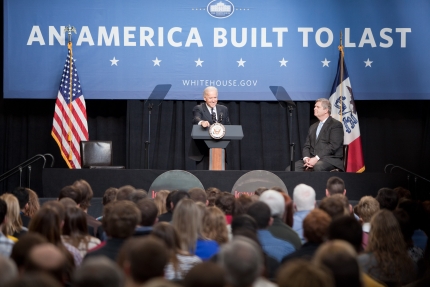A Strong Middle Class Blog
Vice President Biden Speaks To Seniors About Retirement Security
Posted by on July 16, 2012 at 6:52 PM EDTToday, the Vice President spoke to more than 100 community leaders from across the country representing over 60 seniors groups that are part of the Leadership Council of Aging Organizations. He told the audience that when it comes to Social Security and Medicare, “the question is what are we going to do to strengthen and sustain these programs now and for the future.” In contrast, Congressional Republicans are trying to weaken or dismantle these programs.
Last year, Congressman Paul Ryan proposed to end traditional Medicare. His plan, which was embraced by his Republican colleagues, would give seniors a voucher to buy private insurance and hold them responsible for any costs that exceed the value of the voucher. As a result, the typical 65-year-old’s out-of-pocket health care costs would double over time. While Congressman Ryan introduced a revised plan this year, it still relies on a voucher system that would increase the financial burden on seniors.
President Obama and Vice President Biden want to strengthen Medicare and secure the program for the future. Our health care law extends the life of Medicare by eight years by taking smart steps like cutting waste and fraud and creating incentives to cut down on hospital readmissions. These steps will save seniors in traditional Medicare an average of $160 on premiums and copays in 2012 alone. In addition, the law has already saved 5.3 million seniors an average of $600 on prescription drugs by closing the “donut hole,” and has ensured that over 30 million have access to free preventive services like cancer screenings and annual wellness visits.
Investing in the Potential of the Next Generation
Posted by on April 4, 2012 at 1:50 PM EDTEd note: This post is updated with a correction to the number of children who would lose access to Head Start.
Yesterday, the Vice President had a powerful message for the graduating seniors, parents, and teachers at Maury High School in Norfolk, Virginia – one that students across the country should hear and one that drives this Administration’s commitment to higher education. He told the Maury students:
You are the most qualified generation in history. And we have an obligation. We have an obligation to equip you or at least give you the opportunity to go out and plumb that potential.
For months now, Vice President Biden has been traveling around the country talking about the importance of college and the need to make it more affordable. But the graduating seniors and parents the Vice President spoke to and heard from yesterday know all too well that college isn’t as accessible as it used to be. And when college isn’t accessible, the potential of the next generation is at risk. As a result of rising tuitions and the tough economy, more and more families are facing difficult choices about how or even if they can finance a college education for their children.
As the Vice President said yesterday, that’s why this Administration has consistently focused on making college more affordable and accessible for low-income and middle-class families. Since President Obama and Vice President Biden took office, this Administration has supported college affordability and access through multiple measures:
- We increased the maximum Pell award from $4,731 in 2008 to $5,550 today. Nearly 10 million students go to college with the help of a Pell grant each year.
- We made our education spending go further by ending subsidies for banks that act as middlemen for federal student loans.
- We created a tax credit that provides up to $2,500 per year – that’s $10,000 over four years – to help students and their families pay for tuition, fees and books. An estimated 9.4 million families are expected to claim this tax credit for 2011.
- We reformed the way students pay back their federal loans, so students will be able to cap their monthly payments at 10 percent of their discretionary income. This will help make sure that graduates aren’t forced to choose between paying for food or rent or their college loans.
Talking American Manufacturing at Iowa State University
Posted by on March 7, 2012 at 7:32 PM EDTLast Friday, Vice President traveled to Ames, Iowa to talk about the importance of strengthening the American manufacturing sector at Iowa State University’s College of Engineering. Speaking to hundreds of students and faculty, the Vice President argued that manufacturing jobs are coming back to the United States and talked about the reasons that manufacturing matters—not just to people who might one day work in manufacturing like the engineering students at Iowa State, but to the entire U.S. economy and to the American middle class.
The Vice President described how between America’s unique economic advantages and the rising costs of doing business in countries like China, more and more companies are choosing to bring jobs back to the America.
He also emphasized that our skilled workers and engineers—like those trained at Iowa State and other leading American universities—are one of our greatest economic assets. The unique environment at America’s research universities equips students not only with strong technical skills, but with an unmatched capacity for innovation.
“Here at Iowa State and every university in America,” the Vice President said, “you understand that change only comes through challenging orthodoxy, challenging the established norm, challenging the system that you’re working on ... And that’s the environment where the next generation of great ideas is going to come from.”
Learn more about EconomyVice President Highlights New College Affordability Proposals at Florida State
Posted by on February 8, 2012 at 6:56 PM EDTThe Vice President visited Florida State University on Monday to talk with students about our comprehensive plan to address rising college costs. The Vice President began by calling on Congress to permanently extend the $2,500 per year American Opportunity Tax Credit for tuition and other expenses, double the number of work-study jobs over the next five years, and help 7.4 million borrowers by stopping the interest rates on federal student loans from doubling later this year.
These proposals are important, but increasing federal aid is only part of the solution. States and universities also share some responsibility for reining in costs. The Vice President detailed our plan to steer federal campus-based aid to schools that keep tuition affordable – and away from schools that don’t. While we plan to significantly increase the availability of campus-based aid by offering more Perkins loans to needy students and creating more work-study slots, the additional dollars will only flow to colleges that are providing good value to their students.
We are also proposing to create a new “Race to the Top” for college affordability and completion. This competitive grant program will encourage states to reform their higher education systems in ways that lower costs and increase completion rates. And because state funding cuts are one of the primary drivers of tuition increases at public universities, any state that wants a grant will have to promise not to slash funding for higher education.
You can learn more about our plan here.
Higher Education and the Middle Class Bargain
Posted by on January 13, 2012 at 7:45 PM EDTThe Vice President visited high schools in Columbus, Ohio and Doylestown, Pennsylvania this week to highlight our Administration’s efforts to make college more affordable for all Americans. He was joined by Secretary of Education Arne Duncan and Senator Sherrod Brown in Ohio, and by Deputy Secretary of Education Tony Miller in Pennsylvania.
Speaking at Lincoln High School in Columbus, Ohio on Thursday, the Vice President called for the “bargain with the middle class” to be restored: “There was a bargain in place for last 50 years that if you worked hard, you played by the rules, you helped increase productivity in America, you got a piece of the action. You benefited.”
President Obama and Vice President Biden believe that making college affordable is an essential part of restoring that bargain. Our Administration has increased the maximum Pell Grant award by more than $800 and created the $2,500 per year American Opportunity Tax Credit. Even with more generous grants and tax credits, most college students borrow money to pay for school, so we are also limiting federal student loan payments to 10% of discretionary income.
The Vice President Talks College Affordability in Florida
Posted by on December 9, 2011 at 1:16 PM EDTThis week, Vice President Biden and Secretary of Education Arne Duncan visited Fletcher High School in Neptune Beach, Florida to talk to students and their parents about college. President Obama and Vice President Biden have focused on making college affordable for middle-class families since the day they took office. We increased the value of the maximum Pell Grant award by more than $800 and created the American Opportunity Tax Credit, which is worth up to $10,000 over four years for tuition and other expenses. Even after grants and tax credits, most students still need to borrow money for school. That’s why we are allowing borrowers to cap federal student loan payments at 10 percent of their discretionary income.
The Vice President reminded the audience of all these accomplishments, but he didn’t stop there. As proud as we are of this Administration’s record, increasing student aid is just one part of keeping college affordable. State higher education leaders and individual schools must also do their part. On Monday, the President gathered a group of college presidents at the White House to talk about rising college costs and strategies they can pursue to reduce these costs. In Florida, the Vice President argued that colleges "can cut cost and limit student debt without in any way compromising the quality of an education." He acknowledged that "it won’t be easy" but forcefully concluded that "there is no excuse for complacency."
Finally, the Vice President assured students who might be concerned about rising tuitions and debt loads that going to college is an excellent investment. College graduates earn more money and have a significantly lower unemployment rate than high school graduates with no post-secondary degree. And as the Vice President told the audience, "having a college degree is about a lot more than how much money you make. It’s about the independence it bestows upon you, the significantly broader range of choices it gives you…it’s about your sense of self-worth…it’s about being able to fulfill your potential."
Brian Levine is Deputy Domestic Policy Advisor to the Vice President
White House Blogs
- The White House Blog
- Middle Class Task Force
- Council of Economic Advisers
- Council on Environmental Quality
- Council on Women and Girls
- Office of Intergovernmental Affairs
- Office of Management and Budget
- Office of Public Engagement
- Office of Science & Tech Policy
- Office of Urban Affairs
- Open Government
- Faith and Neighborhood Partnerships
- Social Innovation and Civic Participation
- US Trade Representative
- Office National Drug Control Policy
categories
- Blueprint for an America Built to Last
- Equal Pay
- White House Internships
- Civil Rights
- Defense
- Disabilities
- Economy
- Education
- Energy and Environment
- Ethics
- Family
- Fiscal Responsibility
- Foreign Policy
- Health Care
- Homeland Security
- Immigration
- Inside the White House
- Poverty
- Rural
- Seniors and Social Security
- Service
- Taxes
- Technology
- Urban Policy
- Veterans
- Women
- Additional Issues













